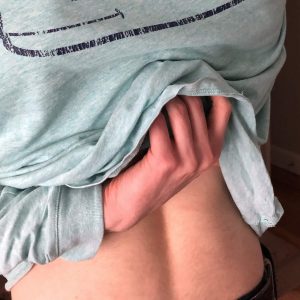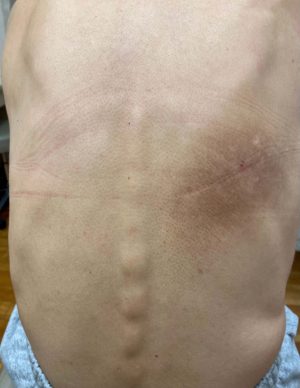- Home
- Blog
- Medical Dermatology
- Itchy Back? It may be more than just dry skin
Itchy Back? It may be more than just dry skin
 Itching on the back can be incredibly frustrating, especially when you can’t reach the area to give it a good scratch! It always seems that the back is itchiest where it is just out of reach. Of course, it is always best to treat the source of itching, in order to avoid scratching. The source may not just be simple dry skin, but irritant contact dermatitis or even a sensory neuropathy. Here is what you need to know about these forms of itching, and how to treat them.
Itching on the back can be incredibly frustrating, especially when you can’t reach the area to give it a good scratch! It always seems that the back is itchiest where it is just out of reach. Of course, it is always best to treat the source of itching, in order to avoid scratching. The source may not just be simple dry skin, but irritant contact dermatitis or even a sensory neuropathy. Here is what you need to know about these forms of itching, and how to treat them.
Simple dry skin
The most common cause of itching on the back is simple dry skin, which is why the condition is always worse in the wintertime, when the humidity plummets and skin is overall much dryer. The amount of lipids (oils) in our skin diminishes as we age, so we tend to get itchier as we get older. Humidifiers in the home can be helpful for improving the skin’s hydration, but the most effective treatment is applying a moisturizer daily. Applying lotion to your back can be difficult, especially if you lack shoulder flexibility. Enlisting some help at home to reach your back with moisturizer is a good option, but lacking that, a simple kitchen utensil can be helpful! A common rubber spatula can be used to extend your reach, allowing you to apply moisturizing lotion daily after bathing in order to seal in the moisture. Excellent moisturizers include: CeraVe Cream or Cetaphil Pro.
Irritant contact dermatitis
Sometimes, if the dry skin is allowed to persist for a long time, the skin loses its normal barrier function and becomes irritated by things we face in everyday life. Common irritants include soaps, cleansers and shampoos that come in contact with the back. Even sweat can be a powerful irritant! Avoiding irritants in this situation can be helpful: keep showers short, rinse the back thoroughly after shampooing, and shower quickly after a workout so that the sweat does not remain in contact with your skin for a long duration. Towel off and apply your moisturizer immediately. If these tips do not work, irritant contact dermatitis may have developed: in this situation, the skin has gone beyond simply being dry and has become inflamed. Your dermatologist may prescribe a topical steroid to treat this condition, along with the usual recommendations of irritant avoidance and moisturizing.
Notalgia paresthetica
Some patients develop a curious itchy patch that develops on one side of the back, just under the shoulder blade, in an area that is maddeningly out of reach. This is called notalgia paresthetica (NP), and it is actually a form of a sensory neuropathy. NP is very common and produces paroxysmal itching on a well-defined patch of skin on the back. The itching waxes and wanes, usually without any clear precipitant. Some patients also report localized burning, pain, prickling, or numbness in the area. The itching is often described as being “under the skin”, which is, in fact, a very apt description because the source is actually an underlying neurologic phenomenon.
 Notalgia paresthetica does not in and of itself show up on the skin. Your dermatologists at SkinCare Physicians see signs of NP, though, because of the secondary changes in the skin related to chronic scratching and rubbing the area. A localized patch of thickened, hyperpigmented skin is seen just below the shoulder blade on one side of the back in the photo on the right.
Notalgia paresthetica does not in and of itself show up on the skin. Your dermatologists at SkinCare Physicians see signs of NP, though, because of the secondary changes in the skin related to chronic scratching and rubbing the area. A localized patch of thickened, hyperpigmented skin is seen just below the shoulder blade on one side of the back in the photo on the right.
The cause of notalgia paresthetica is unknown. Osteoarthritis and degenerative cervicothoracic disc disease or direct nerve impingement may play a role. In one study, more than half of patients had x-ray changes in their spine suggesting disc disease in the cervical spine, where impingement of the nerves at the C4-C6 levels may play a role.
Notalgia paresthetica is not a primary skin disorder, it is a neurologic one. Treating the overlying skin irritation due to scratching may improve the secondary effects, but this does not address the itching from the underlying neurologic disorder. Physical therapy, massage, chiropractic manipulation, transcutaneous electrical nerve stimulation (TENS), and acupuncture have been reported helpful. Topical capsaicin may be applied daily to deplete the nerve endings of substance P, a neurotransmitter chemical, that causes itch or pain. Capsaicin is a natural chemical derived from chili peppers, and it has been demonstrated effective in treating several types of neuropathic pain, including NP. Capsaicin cream can be purchased over-the-counter and applied three times daily to the area affected by NP. Just as a kitchen rubber spatula can be helpful for applying moisturizers, it can be used to apply the capsaicin cream as well. Be sure to rinse your hands thoroughly after application, because getting capsaicin cream in your eyes can cause burning.
If your back is itchy, put away the back scratcher and schedule an appointment with your dermatologist at SkinCare Physicians. We can help diagnose the specific cause and get you on the right track to treat it!



I have this problem, but it started as a more general itch/prickle acoue of years ago. Now is just below my shoulder blade, but moves from one side to the other. I wonder if I might have this condition or something else.
We recommend that you visit your dermatologist so that they can help precisely diagnose and treat your itching.
Itching is giving me more stress especially at the back, when I take bath is worse. Sometimes I just feel itching when am a bit sweat. Please help what is the cause am afraid of cancer.
There are many reasons why you might have developed itching in your back. If you have followed all of the tips recommended in this blog post, you should visit your dermatologist so that they can help precisely diagnose and treat your itching.
I am always having hitching at my back. What can I do to stop this problem?
There are many reasons why you might have developed itching in your back. If you have followed all of the tips recommended in this blog post, you should visit your dermatologist so that they can help precisely diagnose and treat your itching.
My back itches all year round it just always itches, I am 72 years old what can I put or take to stop the itching. Help
There are many reasons why you might have developed itching in your back. If you have followed all of the tips recommended in this blog post, you should visit your dermatologist so that they can help precisely diagnose and treat your itching.
Hi I have had an extremely bad itch on the right side of my back just near my shoulder blade for 7 years it never goes away it’s drives me crazy there’s nothing there to make it itch I wondered if it could be an internal thing like under the skin what do you suggest I can do to relieve this itch
There are many reasons why you might have developed itching in this area. If you have followed all of the tips recommended in this blog post, you should visit your dermatologist so that they can help precisely diagnose and treat your itching.
Having itching at my back and armpit and my tummy over three weeks now what could have been the cause
There are many reasons why you might have developed itching in these areas. If you have followed all of the tips recommended in this blog post, you should visit your dermatologist so that they can help precisely diagnose and treat your itching.
Hi I have alot of skin tags and warts around my neck and back.They are very itchy and I need help to get rid of them.pls advise
That does sound uncomfortable. Your dermatologist should be able to assess this and advise you about the next steps.
I suddenly got itchy saw burning in the centre of my back, could it be sun burn as I was out yesterday with no shirt on it is very painful and I want to scratch
There are many reasons why you might have developed a new itchy spot on your back. If it is also painful, it would make the most sense to have this evaluated by your doctor
Hi there, my back has been itchy for 2 weeks, really not sure what has caused this. I do drink at least 2 litres of water a day, I am very puzzled. What shall I do to resolve my itchy back?
If you have followed all of the tips recommended in this article, a visit to your dermatologist is in order so that they can help precisely diagnose and treat your itching